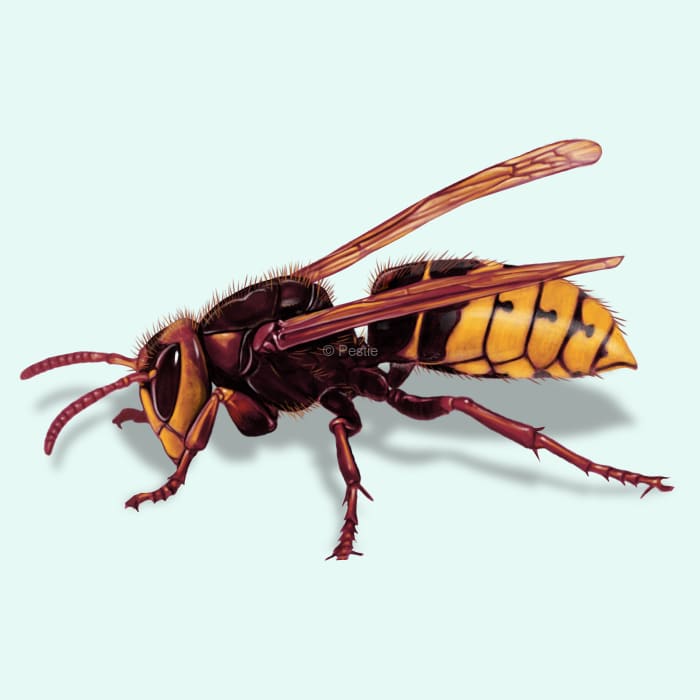How to identify and get rid of hornets

Say goodbye to hornets: expert tips for a sting-free yard
Hornets get a bad rap.
There we said it.
Even though these fierce flying warriors can make any homeowner worry for their safety, hornets actually do more good than bad.
Technically speaking, North America doesn’t have any native “true” hornet species. But, the invasive European hornet now calls the eastern half of the US home.
European hornets nest in the cavities of hollow trees, barns, sheds, attics, or even abandoned beehives. They are typically non-aggressive until their nest is disturbed, and then they can really bring the hurt to the unlucky intruder.
These social insects can create large nests that host between 200-400 members at one time and unlike other bees and wasps, are active at night.
How to identify hornets
European hornets are large wasps that have dark brown bodies with a reddish head and yellow stripes on their abdomen. The abdomen is also marked by four rows of black teardrops that look like they are dripping down the abdomen.
European hornets build their nests out of wood fiber that is mixed with their saliva to create a paper-like substance.
They also make a very loud buzzing sound, louder than most wasps and bees, especially when they are around their nests with other hornets.
How big are hornets?
These are some of the largest wasps we have in the US, measuring between ¾ and 1 ½ inches in length.
What other wasps look like a hornet?
The hype around the northern giant hornet or “murder hornet” has caused some confusion among concerned homeowners. While the European hornet is a large wasp like the northern giant hornet, there are some differences between the two species.
First, northern giant hornets are only found in an isolated region of Washington State and aren’t found anywhere else in US. Additionally, they have solid black and yellow stripes without the black teardrops on the abdomen. The northern giant hornet is also more aggressive and has a neurotoxin in its sting.
Other wasps that look like European hornets include cicada killers and yellowjackets.
Where do hornets live?
European hornets are originally from Europe and came to North America in the 19th century. They are only found on the eastern side of the US currently.
They make large nests in the hollows of trees, and so can be found in forests, parks, and residential yards. These nests only survive for one year and fertilized queens will make a new nest after overwintering. Sometimes these queens may come inside accidentally and can be found in attics or living areas.
How to get rid of hornets
European hornets may become an issue if a nest is found in your yard or nearby. But, if they aren’t disturbed, they won’t aggressively sting like yellowjackets. European hornets can be helpful for gardeners, as they prey on large vegetable and fruit eating insects.
If you find a wasp in your home, it’s best to either catch and release it, or kill it immediately before it can sting someone. Sealing cracks around the home can prevent hornets and other pests from entering the home when the weather turns cold.
You can also use a barrier spray, like Pestie, to keep hornets from coming inside. Our pro-grade DIY solution is applied on the interior and exterior to create a bug barrier that protects your home.
Treat hornets with Pestie
If you're still having trouble keeping hornets away, the best option is to use a pro-grade, effective pest control solution like Pestie.
Pestie is a do-it-yourself pest control solution that's specially designed to keep hornets and other pests away from your home.
With Pestie, you can rest easy knowing that your living space is protected and free of creepy crawlies. And the best part? It's designed for people, pets, and the planet, so you can say goodbye to harsh chemicals and hello to peace of mind!
- Save hundreds compared to traditional annual pest plans
- People, pet, and planet-friendly
- Pro-grade customized formulas
Quick facts
How dangerous are Hornets?
Medium danger risk
While they look big and intimidating, European hornets aren’t very aggressive and their stings are about as bad as a honeybee. However, their stingers aren’t barbed like honeybees, so one hornet can sting multiple times. The only concern would be for those who are allergic to bee stings and need to take extra precautions.
- Scientific name
Genus - Vespa
- Other common names
Bald-faced Hornets
- Colors
Brown with yellow stripes on abdomen
- Life span
1 year
- Diet
Large insects (grasshoppers, caterpillars, yellowjackets, bees)
Hornets are nocturnal and are attracted to lights. They have also been known to make a startling thud when they crash into windows at night!








